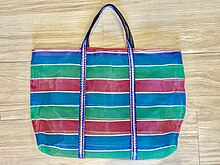Gaji bags (Chinese: 茄芷袋; pinyin: Jīa Zhǐ Dài) are large, typically unfastened bags with parallel handles that emerge from the sides of its pouch, often used as reusable shopping bags. Gaji bags originated from the rural village of Jing Liao in the Houbi District of Tainan, Taiwan during the Japanese Colonial Period.[1]

Etymology
The name "Gaji" comes from the Japanese term for bag weaving, かぎ編み (kagiami).[2]
History

Initially woven by rice farmers seeking extra income, these bags were crafted from Cyperus malaccensis, a plant abundant in nearby marshes. During Taiwan's industrialisation in the 1960s, Gaji bags transitioned from plant to machine-sewn nylon mesh, offering higher durability and affordability. Thus, Gaji bags became popular Taiwanese household items due to their practicality, used by mothers for grocery shopping and farmers for harvests. However, they faced a decline in the 1980s among younger consumers seeking more fashionable alternatives.[3]
The resurgence of Gaji bags began in the early-mid 2000s, after the documentary film Let It Be released in 2004 highlighted the resilience of Jing Liao farmers, while a famous singer adopting the Gaji bag as a logo further boosted its popularity.[4]
Today, Gaji bags have evolved beyond traditional handbags, with designers incorporating the nylon mesh into various products. Available in a range of colours and styles, they appeal to both older generations, valuing heritage, and younger generations appreciating retro-chic aesthetics as well as foreign travellers to Taiwan.[5][6]
References
External links
